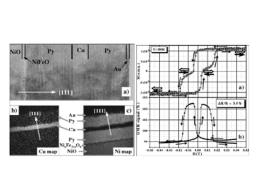
Fig.1:(left)(a) HR-TEM image with atomic resolution for a fully epitaxial 25Å Au/100Å Py/50Å Cu/100Å Py/NiO(111)spin-valve after
annealing at 700 K for 10 min.(b),and (c) EFTEM chemical maps at the Cu L2,3 and Ni L2,3 edges. White contrast indicates the presence of the investigated element.(right) Hysteresis loops measured by VSM (a) and GMR in CIP transverse geometry (b) for the spin-valve.
Fully epitaxial spin valve structures enable disentangling individual parameters contributing to the exchange bias effect. Antiferromagnetic oxides are used to pin the magnetization of ferromagnetic metal layers. The preparation of fully epitaxial spin valves elaborated on NiO(111) single crystals by means of molecular beam epitaxy techniques, with permalloy (Ni80Fe20), Co, Co30Fe70, and Co/Co30Fe70 as pinned layers, were investigated by surface X-ray diffraction, electron transmission microscopy, atomic force microscopy, vibrating sample magnetometry and electron transport measurements. [1] The best results were obtained with permalloy (Py) being the pinned layer with a giant magnetoresistance (GMR) of 3.5% at room temperature. The detrimental effect of an inter-diffusion at the ferromagnet/NiO interface has been evidenced. A 0.8-nm-thick CoFe layer has been found as being an excellent and efficient wetting layer for Co. These model structures allowed a decoupled investigation of the different parameters although the nearly isotropic GMR response of these structures makes them also interesting devices. The microstructure and the exchange coupling were investigated together. At room temperature, the major effect of the exchange coupling on single crystalline NiO(111) substrates is an inversely proportional behaviour of the coercive field of the pinned layer with respect to the ferromagnetic layer thickness. The effect is understood as resulting from the energy losses in the antiferromagnet because of irreversible losses in the antiferromagnetic order.
The growth mode and interface reactivity of the prototypical Co/α-Fe2O3(0001)/Pt(111)ferromagnet/antiferromagnet interface has been considered more recently using oxygen plasma assisted grown hematite epitaxial layers. [2] The chemical composition of the interface has been determined by means of X-ray absorption spectroscopy, X-ray magnetic circular and linear dichroism and the morphology of the growing Co film by scanning tunneling microscopy. We could evidence a 3D growth mode and the presence of a spatially limited reactive interface that spreads to approximately one atomic layer on either side of the interface. Kinetic limitations due to the diffusion of O in Co are most likely responsible for the very limited interfacial diffusion. This area is chemically composed by a layer of reduced hematite and a layer of oxidized cobalt. In the early stages of growth the interface composition is found to be dependent on the Co coverage and reaches quickly a steady state of fixed composition. At 2.5 nm the Co islands coalesce. X-PEEM magnetic domain imaging revealed a strong exchange coupling across the interface.
REFERENCES :
[1] C. Mocuta et al., Phys. Rev. B 68, 014416 (2003)
[2] O. Bezencenet et al., Surf. Sci. (2007)
•  Électronique et optique du futur › Nanomagnétisme et oxydes : spintronique, matériaux multiferroïques et nouveaux capteurs magnétiques
Électronique et optique du futur › Nanomagnétisme et oxydes : spintronique, matériaux multiferroïques et nouveaux capteurs magnétiques
• Service de Physique et Chimie des Surfaces et des Interfaces



